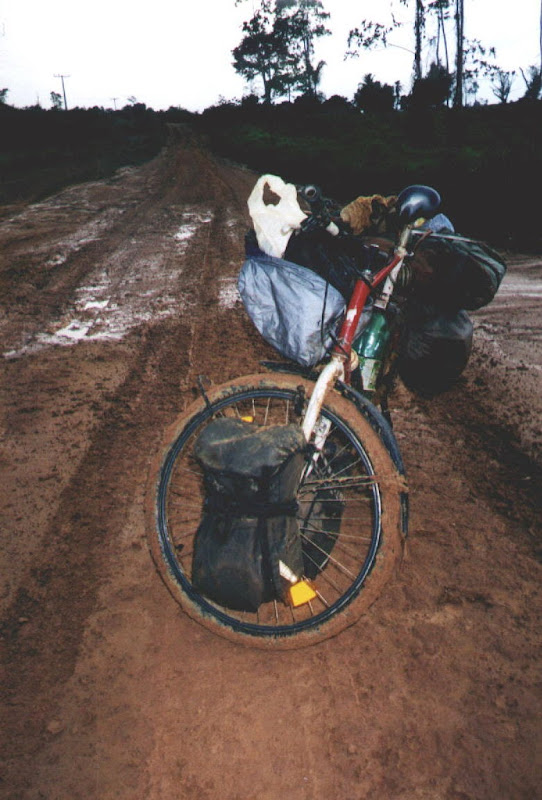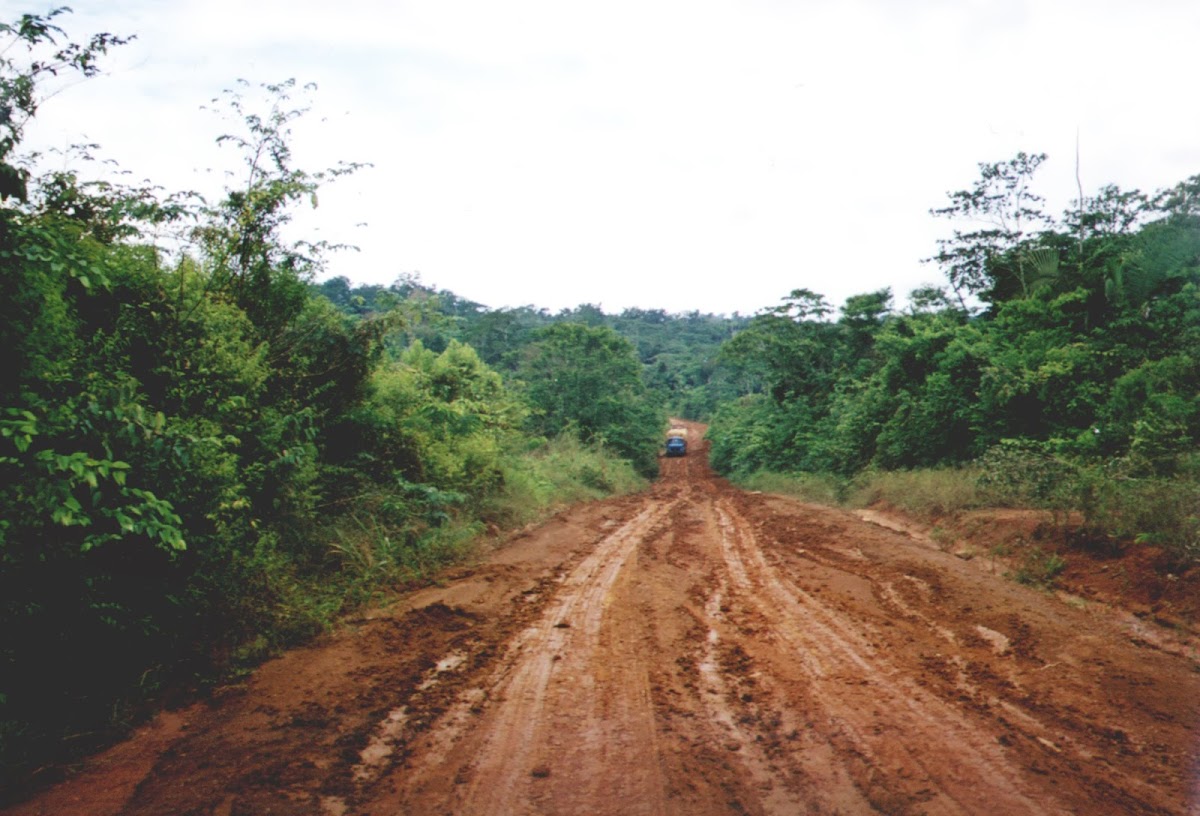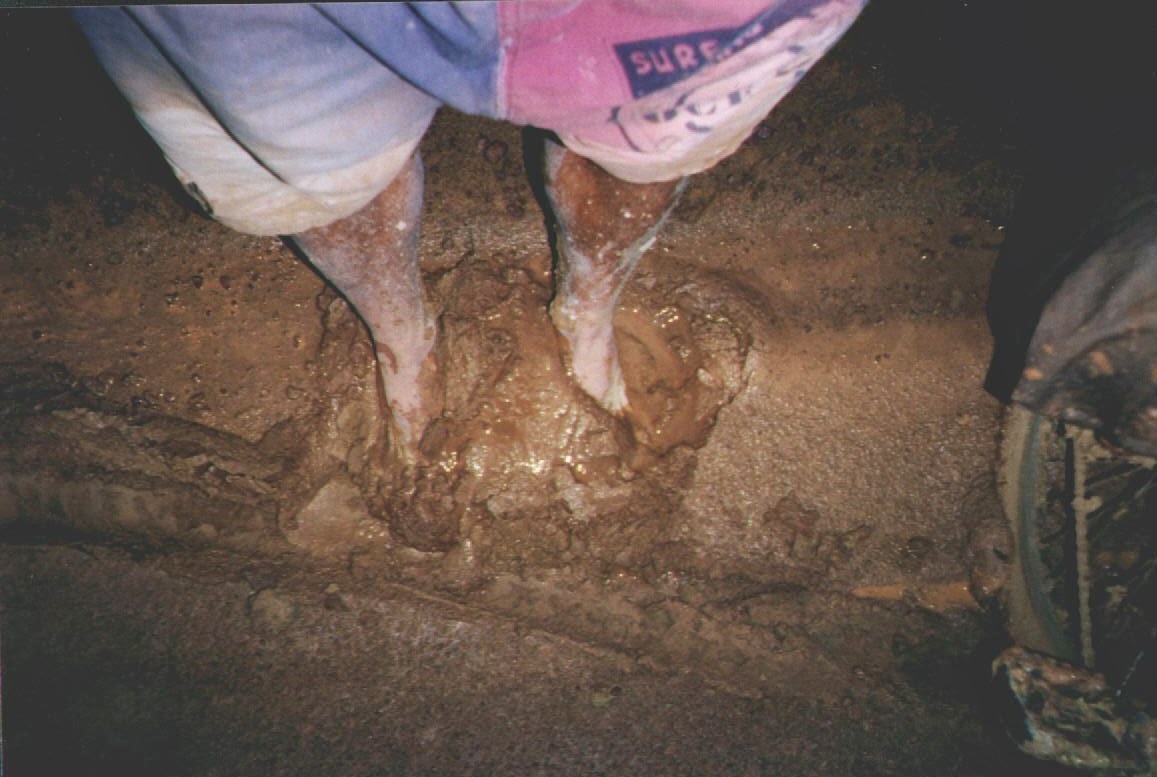Oct 28th
 The road out of Altamira continued hilly, but not as steep as before, and once in a while there were even some flat kilometers. The sun was shining and a made a good average.
The road out of Altamira continued hilly, but not as steep as before, and once in a while there were even some flat kilometers. The sun was shining and a made a good average.

As the days before, I passed a lot of small farms and some tiny villages. One of them, Novo Brasil, is especially funny. It seems to be designed to be a big town someday, but up to now it consists only of a few houses. However, the Transamazônica splits up into 6 lanes, each one separated from the other by stripes op grass, decorated with flowers, trees and lamps, giving access to other lanes on several big roundabouts. It's as you know it from bigger towns, but there is no town, there are almost no cars and the surface is still the same red dirt as outside...
Brazilians love noise. Some of these small towns boast with central noise facilities: Loudspeakers at every corner, transmitting the same interesting local news the whole day: "The Bus from Altamira will arrive somewhen this afternoon... Attention, please. The grocery store offers bananas for 20 Centavos per Kilo.... The parrot of Dona Maria died tonight and the dog of Sinha Vitoria crossed main road this morning...." Then it's the favorite music of the town's DJ, before it starts all again.... Shops ignored by the town's news channel install their own loudspeakers and place a salesmen with a microphone on the sidewalk (so they have one) who announces his special offers to every passer-bye. Optionally, in towns big enough to have a central square, there are cars with loudspeakers on top, circulating around the square from sunrise to sunset.
The good thing for the hungry and thirsty cyclist is that you can hear that you are approaching a settled place kilometers before...

Since I left Altamira there are less cars and trucks on the road. Sometimes I had the Transamazônica for my own for more than an hour. There are only two (real) cities ahead, Itaituba and Santarem, the later one accessible on a 300-km side road of the Transamazon. Both are more easy accessible via the Amazon and/or Tapajós river, so goods and passengers usually prefer river transport. Most of the trucks bring in only local supply, and most of them stop to ask if I needed any help or if I would like a lift. (Even the ones going the other way...)
Meanwhile they all know me, and some of them seem to be embarrassed if they stop to chat with me and I can't remember that they already passed me this or that day some hundred kilometers away. "What, you haven't seen me in my truck?? Why not, I still remember you!!!". Usually I was referred to as "o louco" or "o doido"...
I made a good distance that day, but soon it's time to look out for a place to sleep. As so often I pull into a small farm. This one is especially funny. It's run by 3 families, they all gather around the fire place and we sit there until late at night.
When I finally stumble back into my tent I find a big spider on top of my pillow.
Oct. 29th
Next morning started sunny. I was lucky so far, I had only few rain, either at night or just short showers that soon dried out. The sun burned down and besides using 50°-sun protector I burned my right hand.
Road conditions are poor in this stretch. It takes all my concentration to maneuver the bike, so I don't notice the black clouds forming up there. I only notice when the first raindrops come down, 5 seconds later I'm completely soaked and another 5 seconds later the dusty road transformed into pure mud.

I try to reach a farm about 500 meters ahead, but there is no chance. The wheels pick up mud until they block, making the bike so heavy that I can't even carry it. I have to leave it on the roadside and "walk" to the shack, more precisely I crawl and slide barefoot.
A truck passes by and tries to climb the next hill, but it's so slippery that he gives up and stops in front of the same farm. It pours down for 3 hours.
In the late afternoon, after the rain stopped, I try to continue, but it's almost impossible. I have to stop every 50 or 100 meter to remove tons of mud, then I can continue for 10 seconds before the wheels block again. The only reason why I continue is to reach a bar which is said to be 3 or 4 kilometers ahead.
It takes me one and a half hours to reach it. Finally, at least some cold beer to flush down dirt and frustration. I meet a Gaucho (a Brazilian originally from the southern part of Brazil) who invites me to stay in his farm tonight, another 2 kilometers or 30 minutes ahead. His family is of German origin, and so my efforts to get there are honored with cold beer, real self-made German bread, sausage and Sauerkraut!!
Oct 30th

It stopped raining, but it was still cloudy. The road didn't dry out very much, sometimes I can cycle for a while, then I reach stretches that are still pure mud. I play this game for the whole day: cycling, pushing, carrying, cleaning, cycling.... The clouds waited for me and each time it started to get easy they opened the valve again to set the road under water.
I sleep that night under Cacao trees which I found some hundred meters of the road, in the middle of the jungle at the end of a narrow, overgrown trail.
Oct 31st
Another rainy day, by 2 p.m. I made 5 kilometers. I passed most of the day in a small bar, filled with the passengers and drivers of two trucks and a pickup, who were stuck there as well.

I'm very frustrated. I planned to reach Itaituba today, but now I will need at least 2 more days. Besides that, all 3 truck drivers insist that the Transamazônica would end in Itaituba, and that the only way to reach Porto Velho is by boat or plane. I heard a lot of stories about road conditions, most of them were not true. For 1000 km I hear something like "this is the good part of the Transamazônica, but there are bad road conditions and bad people on the other side of that hill..." But now I start to worry. So far I haven't found any trucker who made that part, and now truckers who go to Itaituba tell me that it's impossible to continue beyond...
One of the truckers worked here when the road was constructed, and he can explain why the road always climbs as steep as possible to the top of the highest hill available: If they had built it parallel to the hills, the next rain would have washed it away, and down in the valley it would be flooded frequently. The "best" way is to built it straight uphill, so that the water doesn't need to cross it. I don't know if this is true, but at least it sounds reasonable. Bad luck for the cyclist...

At night I reach Rurópolis, a small town at the junction to Santarem. The trucks I saw this morning arrived just an hour before, and they all wonder how I made it there. (I wonder myself) That night I have to tell my story about 20 or 30 times, and as often before I'm told about an English women who passed by some 20 years ago, Luice Southerland, I assume.
Nov. 01st

Yet another rainy day, with not much news to report. The surface is better here, I can often cycle in the rain, barefoot and topless, taking advantage of the small rivers and lakes that form on the road to wash off the mud. Still I have to stop frequently to pass heavy showers. By noon I finish all my books: "Homo Faber" by Max Frisch and, ironically, "Dry life" by Graciliano Ramos, books that would usually take me half a year to read...
Once again I spent the night in the garden of a very friendly family. The father is about my age, but has already 6 kids. We talk a lot, and somehow the subject comes to the new educational program for adults, launched recently by the Brazilian government. He feels very ashamed when his wife tells me that he takes part in that program. He was born as one of 10 kids of a poor family and never had the chance to go to school. Only now he starts learning what he missed in his childhood.
At night I can hear his wife teaching lessons in reading and writing. Then it starts raining again.
Nov 02nd
Yeah, blue sky!!! Finally the rain stopped. There was still a lot of mud on the road, but the sun started to dried out the surface and I was soon able to find my way through. At noon I stopped at a nice, clear river and dedicated a good time to bike cleaning and maintenance.
Finally I could enjoy the landscape again. There was not much fun in jumping into the rivers while having a rain shower, but now I enjoyed them. I wondered why some of them are really cold. For millions of years water comes down at 30 degrees, the air is 30 to 35 degrees warm and everything else too, so where does the water cool down??? Can someone explain that??
I have 30 kilometers to go, it's early in the afternoon and the road becomes better hour by hour, so I see no reason to hurry....until I see the black clouds coming in from the south.
I jump back on my bike and cycle as fast as possible. The clouds chase me for two hours, then I stand on top of the last hill, with a fantastic view down into the Tapajós valley.
The ferry takes half an hour to cross the river. It's the first time I have to pay, they charge 50 Centavos (25 US-Cents) for my bike, and it takes about 10 minutes to find the receipt block for bicycles.
On the other side I disembark right in the center of Itaituba. A real town, even with paved streets. The first thing I do is to cycle 3 times around the block, enjoying the asphalt under my wheels and probably everyone thought I turned completely mad now!!
I arrived on a public holiday, the "dia dos mortos", and the town looked really dead. But at night people came out and there was a big party on the river beach. However, I manage to find back to my hotel before sunrise...
Next part is 400 km along the Rio Tapajós. I found a jeep driver who "frequently" drives to Jacareacanga, which is the one and only town along the way, but at least I finally found out that the road actually exist!!
Até logo
Micha
<-- continue part 4


